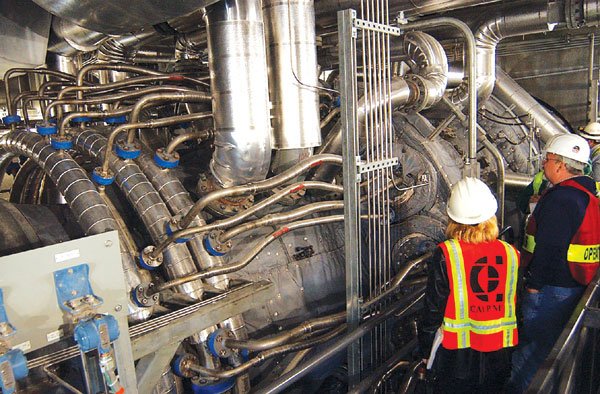Coyote
– It’s that time of year again: baseball, barbecues and threats
of rolling blackouts interrupting summer fun and imperiling
California’s economy.
Energy experts are predicting that California will get through
the summer without an energy disaster barring an unusually long and
searing heat wave, but just barely, and not at all if not for
Calpine Corp.’s new 600 megawatt plant coming online in Coyote June
1.
Coyote – It’s that time of year again: baseball, barbecues and threats of rolling blackouts interrupting summer fun and imperiling California’s economy.
Energy experts are predicting that California will get through the summer without an energy disaster barring an unusually long and searing heat wave, but just barely, and not at all if not for Calpine Corp.’s new 600 megawatt plant coming online in Coyote June 1.
“Under normal conditions we’re going to be OK,” said Gregg Fishman, a spokesman for California’s Independent System Operator. “Our forecast also looks at abnormal, what we call once-in-10-years scenarios, and under that scenario things are little bit tighter. We’re very glad to have this power plant coming online.”
Nowhere near as glad as Calpine. The San Jose company is saddled with a negative cash flow and fending off bankruptcy rumors. Now, after six years of planning and construction, the Metcalf Energy Center is ready to start generating power for San Jose and revenue for Calpine.
“The plant will provide a new source of revenue in an area where there is an identified need for power,” Calpine spokeswoman Lisa Poelle said. “The area is generation deficient and too reliant on imported electricity from remote locations.”
But the power plant is also something of a risky venture. Power plants sell their energy in two ways, through long-term contracts or on the real-time, or spot, market. The spot market is where a company can take advantage of increased demand and higher prices, but long-term contracts underwrite the cost of doing business.
Metcalf has no long-term contracts to guarantee that it can pay to operate the plant, pay its employees and service its debt.
“It’s fraught with worry,” said Gary Ackerman, executive director of the trade group Western Power Trading Forum. “It’s not a good business proposition to be on the spot market alone. There’s no way possible in the current environment for Calpine to recover all of its costs.”
Calpine’s efforts to engage Pacific Gas & Electric Co. in long-term deals have been frustrated because the utility believes Calpine will deliver the energy from Metcalf with or without contracts, Ackerman said. He said running the plant shows Calpine’s need for revenue and its commitment to being a good neighbor.
“I think Calpine is being a good citizen by making sure there is electricity because the state needs it and consumers need it to keep those lights on,” Ackerman said.
And M. Kathleen Vuchetich, an energy analyst with W.H. Reaves in New Jersey, said Friday that Calpine should weather its current troubles and secure contracts when energy prices stabilize.
“It is true that Calpine has real liquidity issues, but they’re beginning to address them,” Vuchetich said. “Having a new power plant that can raise cash is a really good development for Calpine and the state.”
At 600 megawatts, Metcalf will produce enough energy for 500,000 homes, the vast majority of which, Calpine officials say, will go to San Jose, though energy can’t be tracked like other products.
“Think of a power grid as a 55-gallon barrel,” Fishman said. “There are a 1,000 generators pouring water into that barrel and 35 million people sucking water out of it with straws. I can sell my water to a specific user, but I can’t tell who is using which water. But if I have a contract for 10 gallons, and I pour 10, and they drink 10, everybody’s happy.”
There are some people decidedly unhappy that the plant, which covers 11 acres and spills exhaust through two towers reaching 145 feet to the sky, will operate in a rural residential area.
Phil Mitchell, a former South San Jose resident who led neighborhood opposition to the plant before it was approved, said this week that it will harm Coyote’s environment.
“It’s ludicrous to put a large industrial facility that close to residents,” he said. “It’s inconsistent with the general plan for the area. It’s absolutely an inappropriate location for a facility of that scale and that level of emissions.”
But Calpine officials counter that the plant is far less harmful to the environment than traffic and gas appliances and heaters. Metcalf will release about 124 tons of nitrous oxide each year. Figures provided by Calpine show that 600,000 vehicles release more than 50 times that much nitrous oxide in a year.
“And nitrous oxide released by our plant can’t be measured at ground level,” Poelle said.
Metcalf is a combined-cycle power plant that uses natural gas and steam turbine to create electricity. The technology reduces fuel consumption by as much as 40 percent and is substantially cleaner than traditional power plants running on diesel engines. Amid the environmental uproar, the plant won some unexpected allies, including the Sierra Club.
Kurt Newick said the decision to endorse the plant was controversial within the club’s Loma Prieta chapter but came ultimately because new, more efficient power plants are needed so that older, pollutant spewing plants can be shut down.
“It’s actually going to end up cleaning the air in the long run because it will enable highly polluting power plants to run less frequently,” Newick said. “There are minor concerns, but we understand the business reasons behind [them]. Calpine is actually pretty progressive as far as energy companies go.”












